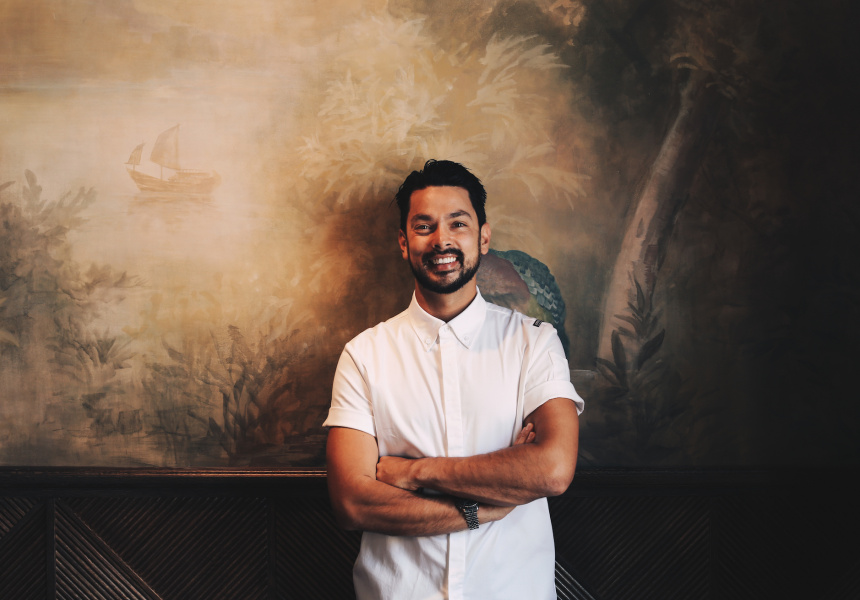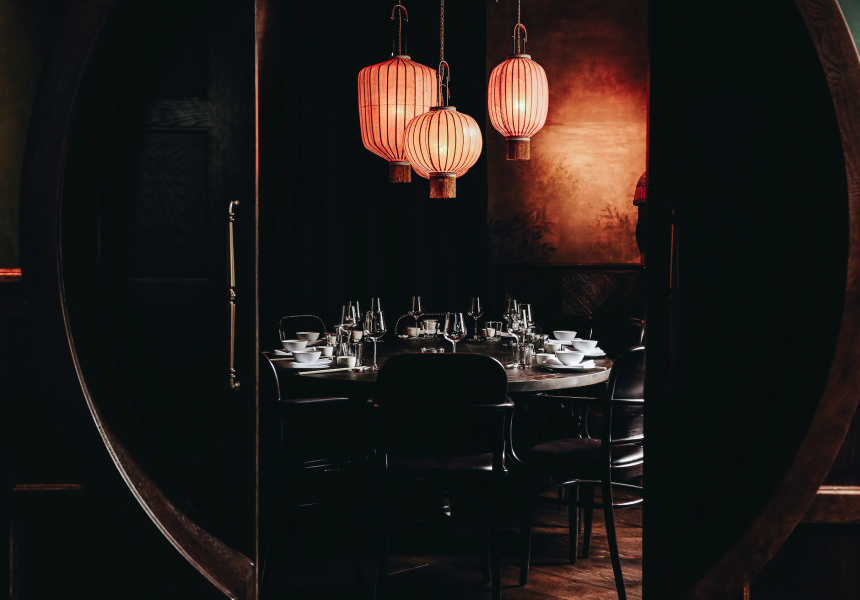The first thing you notice at Stanley is the duck. It’s lined up in the restaurant’s kitchen – box after box after box, neatly queued at the pass. At full capacity Stanley is a sizeable restaurant – 220 seats across two levels and three distinct sections, with a casual bar area attached to the side – but, really? You need this much bird?
Preparing Cantonese-style roasted duck is a four-day process, head chef Louis Tikaram explains, and so you have to be thinking four days ahead. No one wants to run out of duck. “On the first day, you brine, then you dry, then you roast,” he says. “And then you cook it on the day … It’s so important. Everything is in the preparation.”
It’s this kind of precision that defines Stanley, which quietly opened at Howard Smith Wharves. From the careful preparation of local produce to the multiple, specific kitchen spaces to the interior design by Fellow Interiors, which has decked out the heritage-listed former water police headquarters in parquetry, luscious fabrics, water-colour murals and lanterns. It’s a venue-wide exercise in mise en place.
Never miss a Brisbane moment. Make sure you're subscribed to our newsletter today.
SUBSCRIBE NOWAt the centre of it all is Tikaram, newly returned to Australia after five years heading up EP & LP in West Hollywood. Tikaram helped open that buzzy eatery at a time when Los Angeles’s food scene was hitting high gear. There’s an element of history repeating itself with Stanley and Brisbane.
It was Jonathan Barthelmess who planted the seed for the move. The Greca, Apollo and Yoko Dining restaurateur was in LA celebrating his 40th birthday when he started talking up the city to Tikaram.
“We’ve known each other for years and he said to me, ‘Louis, you won’t believe how amazing Brisbane is’,” Tikaram says. “I came and looked for myself and it was a really up-and-coming food city … When I was first back, I had a beer with Darren Robertson at Three Blue Ducks and he said Brisbane reminded him of Sydney 10 years ago … It’s a really exciting place to be.”
Perhaps surprisingly, Stanley is the first time Tikaram has tackled an entire menu of Cantonese food. The cuisine references a lot of things for him: his great grandfather’s Chinese restaurant in Fiji, post-service chef chow-downs at Golden Century when he worked in Sydney. Most of all, though, it’s about the produce.
“That’s why I like it,” Tikaram says. “You don’t muck around with it. You get the good produce, you steam it, you stir-fry it and you get your sauce right. Jowett Yu from Ho Lee Fook in Hong Kong says some of the best Cantonese in the world is in Australia, because we have such good produce.”
That’s why Tikaram and Howard Smith Wharves executive chef Patrick Friesen wrote Stanley’s menu around the produce. There’s steamed Hervey Bay scallops with vermicelli and XO sauce, wok-fried Glacier 51 toothfish with Chinese celery, cloud fungi and supreme sauce. Or Tikaram’s favourites: a painted tropical crayfish lo mein, and line-caught red emperor (when it’s available) steamed with ginger, shallot and white soy. Beyond the duck there’s a generous selection of barbequed meat and bird alongside dim sum, a stack of noodle dishes, and mud crab or Moreton Bay bug live from the tank.
It’s impressive stuff, backed by an enormous 400-bottle wine list courtesy of head sommelier Thibaud Cregut, previously of Nel in Sydney.
Something like Stanley also adds heft to the Brisbane restaurant scene’s changing relationship with suppliers. No longer is Queensland produce always run through the preposterous supply chain that would often see it travel to the city via Sydney and Melbourne. If anything illustrates that the city’s food scene is having a moment, this is it.
“That’s one of the reasons I wanted to come back to Brisbane,” Tikaram says. “Not just to be back home close to Mullumbimby [where he’s from], but to help get this process rolling and be part of a movement.”
Stanley
5 Boundary Street, Brisbane
(07) 3558 9418
Hours:
Mon to Thu 12pm–3pm, 5.30pm–10pm
Fri to Sun 12pm–10pm
This article first appeared on Broadsheet on November 6, 2019. Menu items may have changed since publication.



